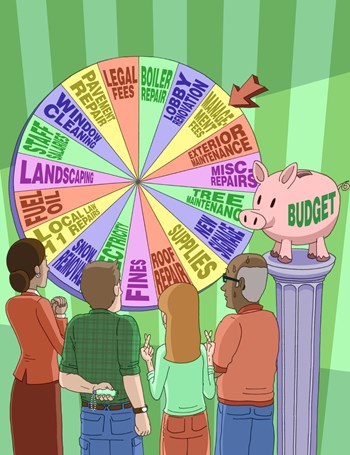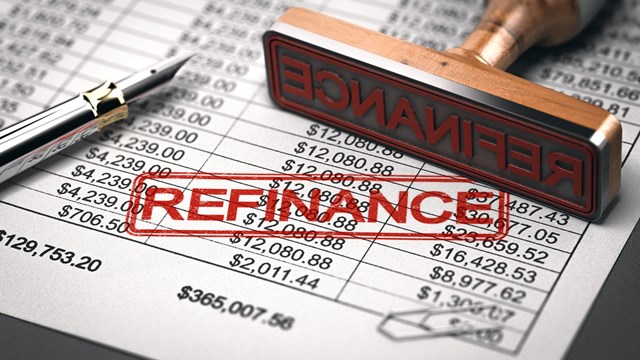
Even in the best of economic times, preparing a condominium’s annual budget is a tiresome task, fraught with uncertainty, estimations and shifting numbers.
Now, factor in one of the most challenging economic downturns in a century with cash-strapped owners who may be “skipping” monthly maintenance fees or common charges—or even winding up in foreclosure—and you have a downright daunting task.
The importance and economic challenges of this year’s annual budget are not underestimated by CPA Gary Rosen, with the East Brunswick-based Wilken & Guttenplan, PC accounting firm. “A budget is a tool put in place in the beginning of the year to determine the quality of life and level of services that you want to have within the community. Make that budget not only looking from an internal view, but also external, as to what’s happening in the industry and the economy as a whole.”
Getting that “plan” into action is no small feat but it does follow a consistent path year after year. Usually, beginning in July or August, the management company or the association’s treasurer will conduct the upfront preparation, analysis and initial drafting of the budget. As with most things in life, the upfront preparation proves to be the most overwhelming yet most important aspect of the budget process.
By September, the first draft will be presented to the association, and after an average of three meetings, a finalized budget is put to vote for approval by the end of December. From start to finish, close to half a year is devoted to the budget process.
“Fixed Costs” No Longer Fixed
It’s estimated that about 80 percent of a condominium’s operational costs are fixed. However, in this economy many of those previously fixed costs are up for grabs and require more careful research and analysis than in previous years.
The first step is to review the current year’s first eight-months billing cycle, and compare that to the previous year’s budget to yield the average projected costs of items such as utilities, insurance, repairs and the like.
What in previous years may have been viewed as safely averaged costs (as an example, the water bill) may not be the case this year. Other utility costs, such as electricity, will prove even more difficult to average because they are dependent on fluctuating market factors such as gas prices.
Karen Sackstein, a Fair Lawn, New-Jersey CPA has seen her share of annual budgets. She advises co-op and condo boards to consider any and all available cost cutting measures in the areas of conservation and competitive bidding “for more creative ways to save.”
“These [measures] could include using volunteers from the building with an expertise in a certain area,” says Sackstein. “Utility costs might be reduced with a conservation plan. Insurance costs can be reduced by shopping around for the best [priced] policy, increasing deductibles or self-insuring for certain types of losses.”
Repair costs are more of a moving target and can fluctuate yearly. Some years experience an unexpected onslaught of repair needs, as seen by this winter’s ice storm. Therefore calculating an accurate projected cost can be challenging. Reoccurring data is fairly predictable, so experts advise reviewing the historical average cost of repairs and factoring in the consumer price index increase.
Repairs are not the only unexpected costs caused by each winter’s storms. Some cooperative and condominium communities will experience increases in insurance premiums due to claims filed as a result of storm damage. Associations may need to contact their insurance agents to get an accurate assessment of what increases to expect.
Other cost savings can be seen in discretionary maintenance costs. If the building is normally well-maintained, then foregoing work on aesthetically-based projects will not be an issue and will assist in lowering budget costs.
Delinquencies and Foreclosures Rising
Many owners, hard hit by the economy, are finding it more challenging to make their monthly payments. In the past eighteen months, Sackstein has seen a significant increase in delinquencies and forclosures. Rosen, too, acknowledges the increase in delinquencies as well, but notes that arrearages and foreclosures vary upon the socio-economics of a particular community.
“We have seen in the more senior type communities less of a problem. However, one of the things associations should do is they should include a line item in their budget entitled ‘bad debt expense.’ Essentially... they are trying to estimate how many unit owners will not be paying or [are] slow paying,”says Rosen.
Some communities have had to raise condo fees to cover the costs of negligent owners. Sackstein believes that “with proper oversight and management, maintenance fee and common charge increases can be kept in line with cost of living increases.”
However, the answer may lie in long-term planning. “The associations should take a look at not a one-year plan, but maybe a long term plan,” suggests Rosen. “Not looking at what their operating needs are, but [also] what their replacement needs are in the community. But don’t be pigeon-holed into saying we can’t raise fees or we can only raise fees a couple dollars if you need more.”
The rise in condominium foreclosures might prove an added incentive to including a contingency for bad debt to the annual budget. Although foreclosures have not hit the condominium market as hard as single-family homes, they are on the rise and will affect communities throughout New Jersey. “We have seen a significant rise in foreclosures, particularly in associations that were completed and sold during the height of the real estate boom a few years ago,” says Sackstein.
Rosen who has not seen large increases in co-op and condo forclosure attributes this mostly to the preventative measures he has seen boards take with unit owners.
“Most of the associations are trying to work with their unit owners,” he says. Boards are recognizing that these are difficult times. They’re trying to work with the residents because they’re neighbors. I think they’re trying to afford them every possibility.”
Reserve Funds “Dipping”
With the prediction of continued delinquency and forclosure increases, lenders will continue to heighten their scrutiny of a co-op or condo association’s financials before approvaling loans. And of particular interest is the reserve fund.
“Most lenders want the association to have accumulated reserve funds and a regular funding program before lending,” says Sackstein.
The reserve fund is set up for capital improvements, major repairs and maintenance issues not covered by the regular operating budget. Even with the typically conservative vehicles condo associations traditionally invest in (such as CDs or government securities), reserve funds might “dip” in value. This “dip” may impact future mortgage approvals, as many financial institutions are becoming more stringent with requiring reserve funds to maintain a specific percentage of the association’s overall budget.
Both Fannie Mae and Freddie Mac have had such a requirement in place for several years. Both require 10 percent of the condominium’s budget to be earmarked for the reserve fund. The purpose is not only to protect the lender’s investment but also the buyer.
“The intent is to ensure the project’s long-term success,” explains Brad German, senior director of public relations for Freddie Mac. “As you know, when projects (homeowner associations) begin experiencing financial stress, reserves are often reduced. This in turn can affect the overall project’s condition, its ability to maintain adequate insurance coverage and ultimately the market value of the individual units.”
Amy Bonitatibus, senior media relations manager for Fannie Mae, agrees. “This (requirement) is intended to ensure that a project is well-managed and that prospective buyers will not be faced with unanticipated financial hardships like special assessments or large increases in the condo fees due to the lack of an adequate reserve funding strategy.” She also notes that in some cases, the requirement can be waived if it is determined that an association is still able to fully operate with less than 10 percent reserves built into the budget.
With reserve funds playing a part in everything from mortgage approvals to fee increases, it is important to maintain the fund adequately and have a realistic plan in place for its use. This is where a reserve analysis study comes into play.
In its simplest terms, a reserve analysis study is a physical checkup of the condominium building and grounds. Typically, the study reports the life expectancy (when repairs will most likely need to be made) on “big ticket” items such as the roof or pool. Most studies project out 20 to 30 years.
Rosen, however, notes that reserve studies are extremely important as they reduce a board’s liability.
The IRS has three requirements, he says. “First, segregate the monies put away for the future replacements of the common elements because it should not be used in regular operations. Two, communicate to the unit owners how much you are putting away on an annual basis. Number three, have a schedule to support the amounts that collected. So, absent of having that amount those parameters or requirement they could have a negative impact on the association.” Rosen suggests associations commission a study every five to seven years.
Drafting a budget in uncertain times is no easy task and nailing down the financial moving targets that this year’s economic landscape is presenting can unnerve even the most cautious condominium managers and board members. But ultimately the creation of a sound annual budget can prove to be the difference between fiscal stability or a sink-or-swim scenario for many associations. Having a solid financial plan in place will also allow condominiums to build a firm foundation, for this year and years to come.
Hillary Pember is a freelance writer and a contributor to New Jersey Cooperator and other publications. Assistant Editor Melissa Swinea provided additional research for this article.






Leave a Comment